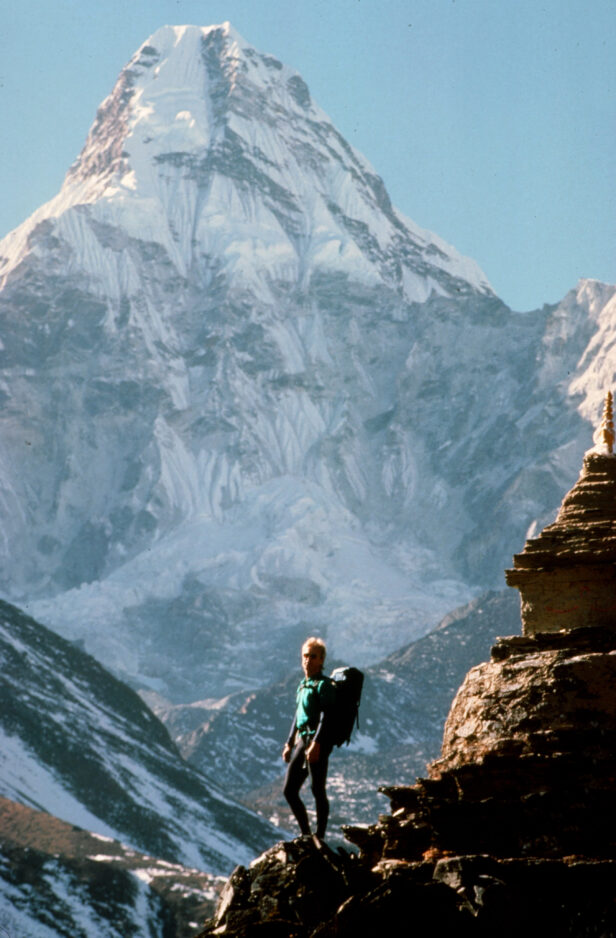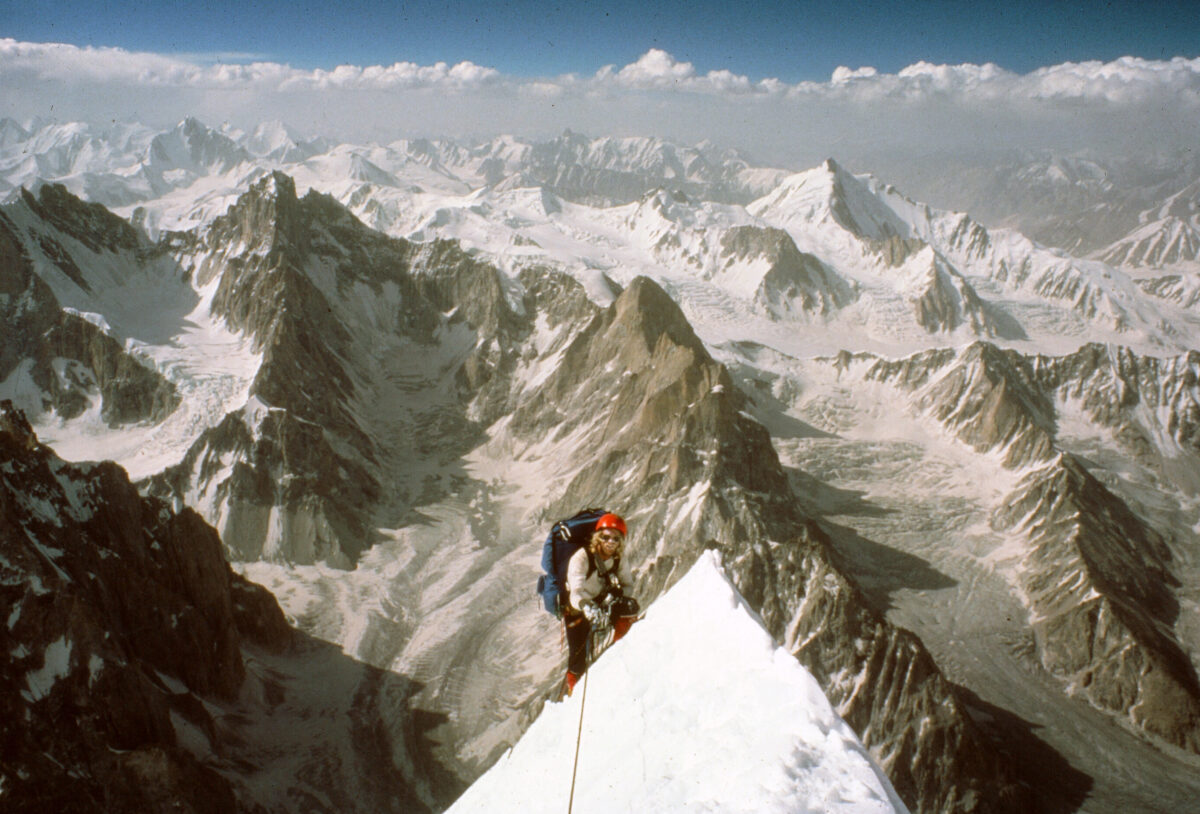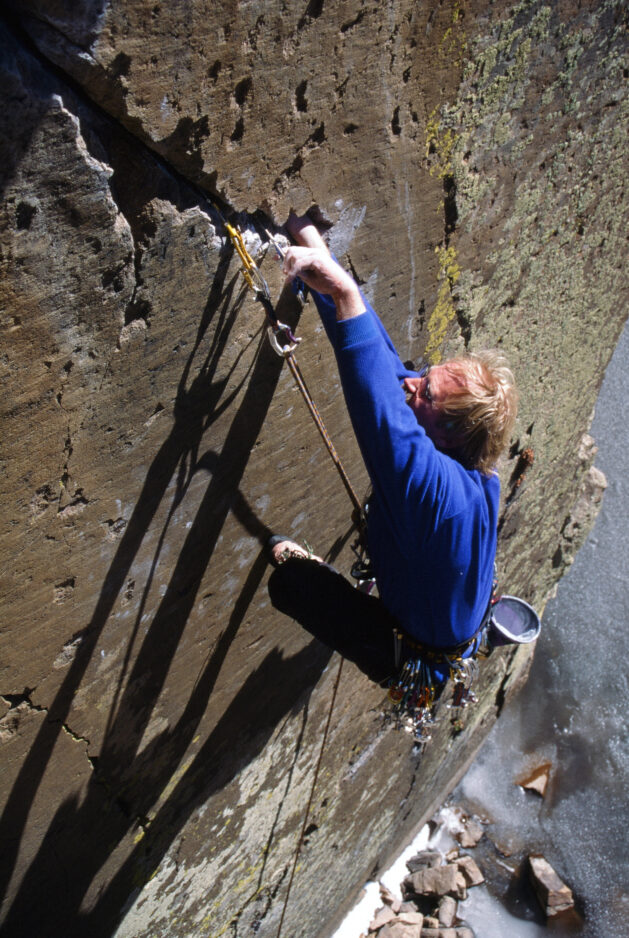Even with degenerative disease, Jeff Lowe still climbing
By 1984, Jeff Lowe was already a god of alpinism and the father of modern ice climbing. Still, he remembered his roots.
The film “Cloudwalker” captured him at the time, and in his prime — strong, brazen, golden-haired, cracking jokes on one of Colorado’s most classic climbs. It also captured a telling quote. Lowe reminisced about camping alone on Mount Ogden, at 14, on a peak that loomed above the backyard of his childhood home. He woke up the next morning, dropped down a 1,000-foot cliff on the east face and climbed it solo. No ropes, no partner, no gear. So marked the beginning of many first ascents.
“To me it was as big an adventure as I’ve had since that point,” he said in the film. “The mountains might be bigger now that I climb, but they don’t get any bigger in my mind.”
Now in a wheelchair at 63, Lowe said little has changed.
“Nothing more to add,” he said, “that quote says it all.”
In many ways, Lowe has come to personify his climbs. Trusting instinct and moving forward. Occasionally choosing the wrong line, then backtracking to find clarity. Embracing fear. Understanding strengths and weakness. Knowing when to go alone and when to rely on others. Aborting when stakes are too high. Celebrating at the summit. Adding it all to an ever-growing body of knowledge and experience.
Lowe’s ailment is still unknown, but doctors have settled on a disease similar to ALS, which progressively degenerates nerve cells. His partner of a decade, Connie Self, watched him move through much of it and understands his current condition better than anyone else. She often speaks and translates for him. Lowe has trouble moving, trouble standing, trouble talking, but he can write with some effort.
“They thought it was a number of things along the way, but he’d always outgrow those symptoms,” Self said, then joked, “I just tell them they should called it JLS, the Jeff Lowe Syndrome.”
Self added that Lowe’s mind remains sound, to which he grinned and quipped, “I’m not sure about that.”
It was in Ogden Lowe learned to climb, alongside his brothers Greg and Mike, and with the blessing of their parents, Ralph and Elgene. As he grew older, he looked to many of the American West’s rockbands, cliffs and ice flows as a means to the sky. That vision took him to summits throughout the world and made him a pioneer in the fringe sports of rock and ice climbing. Over the last decade, Lowe came full circle and brought a climbing renaissance to his hometown, even as his health deteriorated year by year.
Lately, Lowe has captured mainstream attention due to the irony of his condition — a mysterious disease wearing down a man known for his larger-than-life physical exploits. But there’s little that brings Lowe down. Even if he’s stuck spending his life sitting, he’s not one to sit still.
“Living in the present moment is what he did as a climber, as a skier,” Self said, who met Lowe at a California gear shop back in 1980. “I think Jeff has always done the best he can with what he’s got from wherever he is right now, and as he’s progressed through life, he’s developed more skills in other areas that maybe when he was younger he didn’t have.”
Lowe spent most of his adult life in Colorado, chasing more climbing and climbing-related enterprises. He returned to the home of his youth in 2002, on the heels of another failed business, the prospect of another divorce, alienated friends, an expensive lawsuit and the knowledge his body was giving up its mobility against his will.
“I overdid it in some ways,” Lowe said. “I could have maintained better balance. If I had done that, I might have had an easier life but still enjoyed climbing.”
His health problems and subsequent move to Ogden marked a turning point for Lowe and a reassessment of his relationships. He was near his ailing mother during the last years of her life. It was in Ogden he reconnected and rekindled things with Self. He worked to further strengthen his relationship with his daughter, Sonja, the most significant human tie he’s had in his life.
As it happens, his return came on the eve of Ogden’s outdoor revival. When then-mayor Matthew Godfrey brainstormed his strategic plan for the city, he and his advisers identified climbing as a highlight of the city’s outdoor portfolio. Lowe’s name quickly came up.
“(He’s) a world famous climber, hailing from Ogden,” Godfrey said. “We knew we needed to meet with him to give us some guidance in terms of how climbing could fit into our vision, and … to see if he’d be interested in helping us get there.”
By all accounts, Lowe jumped right in. With his donated time and insight, the city introduced a climbing festival, cleaned up local crags and developed a PR strategy. They talked rock climbing parks and ice climbing towers. Lowe turned Ogden into an occasional gathering place for the best mountaineers in the world, and lent more credibility to the town’s outdoor sector. He created a non-profit, Ogden Climbing Parks, to preserve and improve access to the city’s crags. It later morphed into a mentoring organization for youth and the disabled keen on climbing.
By the fall of 2008, Rock and Ice Magazine named Ogden it’s No. 3 top climbing town and Outside Magazine rated it among the top-10 best towns.
“Of course, the successes were rarely reported on. People know less about those,” Godfrey said.
Godfrey and Lowe were visionary, even if some of their ideas felt like castles in the air. With all his contributions to Ogden, Lowe had a few notable failures, which have left a more lasting impression for some. His most infamous project was the ice tower.
The world’s first year-round, indoor frozen tower would’ve topped out at around $1.5 million, swelling from an initial proposed fee of $120,000. Much of the funding would have come from RAMP tax money and the city. The proposed project was hugely unpopular among many locals for its expense.
Lowe said all the projects nearly killed him, literally. By 2008, just after the first Utah High Adventure Film Festival, doctors diagnosed him with Olivopontocerebellar atrophy, guessing he had two to three years left to live. Lowe retired. Ogden Climbing Parks went bust along with the economic downturn, and city administrators officially dropped the tower idea in 2010. While Lowe’s prognosis and diagnosis changed, he felt sapped.
“I fully expected to realize those projects while I had the energy to do it,” Lowe said. “I couldn’t find anyone that had the experience to take over … so I let them go.”
Although public outcry at times was outright hostile, Lowe said through his life, he’s learned “not to sweat the small stuff.”
“I think that’s something that came from climbing, too,” Self said. “He had to climb for himself, believe in himself and do things for his own reasons, and not listen to what other people say.”
Perhaps Lowe’s most overlooked contribution to the local community was to inspire a whole new generation of climbers, even as they watched his body slowly deteriorate over the 12 years he spent fostering a climbing renaissance.
“I won my first ice ax at a Ogden Climbing Park fundraiser he held almost eight years ago,” said Shad Burnham, an Ogden-based climber. “It was his encouragement and assistance (his organization paid for my guide certification) that, in part, drove me to pursue many climbing objectives.”
Burnham has since used that ax on plenty of adventures, and in 2012, he and another Ogden local, Brian Waters, climbed Alaska’s Cassin Ridge. Burnham said the trip was inspired by Lowe’s advice to set his sights high and not worry too much about the details.
Lowe also had the original vision for turning the American Can building into a climbing gym. The Front Climbing Club has since seen enough local success it’s ready to expand the gym by the end of the summer. Meanwhile, Lowe’s ambitions for promoting, teaching and celebrating the sport of climbing endure at the Ogden Climbing Festival, hosted by Weber State’s Outdoor Program, and set to mark its eighth year in 2015.
Brothers Dakota and River Hyde said Lowe has “meant the world” to local climbers.
“I think Jeff’s reputation in Ogden is much smaller than it should be,” Dakota said. “Some of the most inspirational things to me as far as Jeff goes were not necessarily his climbs of old but the climb that he’s on now.”
According to Ogden Mayor Mike Caldwell, the outdoors will continue to be an important economic driver in the area moving forward, thanks to footing gained from Lowe.
“Who can count the number of people he’s inspired to get out in the outdoors?” Caldwell said. “He was inspired by our mountains, and kick-started a passion for being outside … he recognized how uniquely situated Ogden is.”
Just before Lowe and Self left last October, moving once again to Colorado, Caldwell and the city council presented him with a key to the city.
The walls of their second-story condo in a Boulder suburb are decorated with photos, many of a younger Lowe, with his distinctive handlebar mustache, aviator shades, sun-bleached hair spilling out from a knit beanie, high on a slab of rock somewhere, looking completely in his element. Other photos are from later in his life, mostly snapshots of his daughter, granddaughter and portraits with Self. A whiteboard calendar sits in the living room marking their many appointments. Visits from friends. Meetings with the director of Lowe’s upcoming film. Yoga. A fundraiser in Boulder. Interviews with reporters.
When he can, he prefers sitting on the balcony – taking in the sun, listening to the birds, exercising with what little mobility he has left, using the metal railing for balance.
Outside, Lowe still feels most in his element.
“Jeff in the mountains was really in the zone,” Self said. “He was connected to his higher self, that divine part of himself, that had access to his intuition and sixth sense.”
That intuition both kept Lowe alive and enabled him to climb things others couldn’t. But he wasn’t always successful on his epic, often expensive expeditions — Pakistan’s Latok I, Alaska’s Mount Denali and Nepal’s Makalu come to mind. Adverse weather, sickness or an avalanche might have made him turn back, but he could shrug it off. With any luck, he’d be back for a second attempt. He took that same attitude to daily life, with mixed success.
“Intuition kept him safe,” Self said. “Where he had difficulty sometimes was at home, in business or in relationships where he didn’t have that same connection, that same clarity of purpose and clarity of priorities.”
Lowe said he’s still working to rebuild and nurture those relationships. His early emotional recklessness is one of the only regrets he has in life.
“I betrayed my own values and consequently hurt people I love,” he wrote. “I would certainly not minimize the truth to make it more comfortable for myself.”
Colorado is likely the place where Lowe will die, but if he’s afraid of the prospect, he doesn’t show it. He’s been facing death his entire life.
“When we make choices from fear, they are not going to produce positive outcomes,” he wrote. “I call that looking into the crevasse. When you need to cross a crevasse (a large crack in a glacier) you need to look where you want to go … where your attention goes, your body will follow. The same thing is true in life, what you focus on is where you are likely to end up.”
While illness erodes life away, the rocks that first inspired Lowe’s life-long journey help hold his legacy.
“Ogden is where he started climbing, where he learned to climb, Ogden gave him that,” Self said. “I think he would like his legacy to be he learned something and ran with it, and if people can learn something and run with it, you can make a difference.”
Lowe’s final project will likely be his documentary film, “Jeff Lowe’s Metanoia,” which explores his life and one of his last great ascents. In 1991, he traveled to Switzerland to try a new line on the most temperamental side of the most dangerous mountain in the Alps, the north face of the Eiger. It was the first big turning point in his life, even before his disease set in, and was fresh on the heels of his first divorce, first failed business and nagging realization he needed to be a better father to his young daughter.
After climbing into a cave to escape a particularly bad storm, Lowe experienced a hallucinatory spell that gave him clarity and left him changed. Upon completing the climb, he named it “Metanoia,” meaning a transformative change of heart.
Lowe has viewed climbing as a journey to better understanding himself, and his disability is no different. Both have taken him to the edge of the unknown and invited him to take a peek. What lies ahead is another adventure.
“I had a vision of death on the Eiger, and it looked like living to me,” he said.
Private test screenings of “Jeff Lowe’s Metanoia” will be held on Thursday, Aug. 7 at the Salt Lake Library. The film will be shown at 4:30 p.m. and 7 p.m., with a roof reception with Lowe and the Metanoia team between. Tax-deductible donations can be made to a matching funds campaign. For reservations, email vhormuth@americanalpineclub.org. For more about Jeff Lowe, his film and Metanoia, visit www.jeffloweclimber.com.











